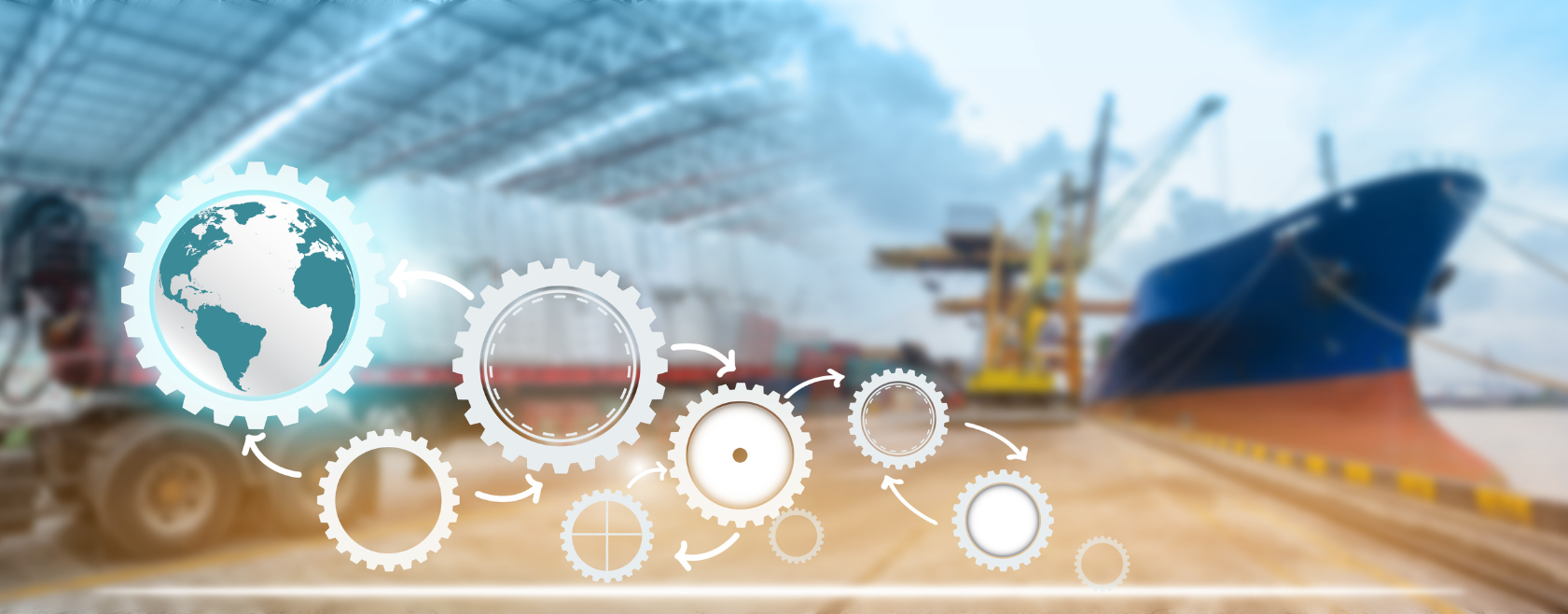Future of Supply Chain Management into 2022 and Beyond
The COVID-19 pandemic forced supply chains to evolve years in the span of months, as leading companies sought to thrive within a logistical landscape never seen before. A shift from low-cost supply chains to a more resilient and agile framework is a major mark of the pandemic, which has left 87% of supply chain leaders planning to invest in resiliency in the next couple years.
This rapid evolution brings to light the question: The future of supply chain management was forced to arrive today, so what should you expect in 2022 and beyond? Let’s take a look at the major trends we at Trax expect to unfold in supply chain management over the next few years.
Higher Visibility in Supply Chain Management
As we saw during the pandemic, increased visibility into your supply chain’s transportation spend allows you to improve areas of weakness, build upon its strengths, masterfully control costs, and plan accurately for future growth. When you have end-to-end visibility of your transportation spend, you can make impactful, data-driven decisions. Gaining higher visibility is a key component of improving your supply chain management process.
By 2023, 50% of global product-centric enterprises will be invested in real-time transportation visibility platforms. Effective supply chain management is achieved through these platforms in two key ways: they allow customers to track their orders in real-time, which satisfies the new customer expectation and eases the burden off your customer support team, and they deliver invaluable insights into your transportation costs and performance.
Forecasting transportation spend is quite complex, near impossible, without proper visibility into your global supply chain's operations and finances, particularly for multi-modal, multi-lanes. However, total visibility into your transportation spend makes it possible to optimize carrier selection, carrier rates, contract management, and routing guidelines.
Enhanced visibility also means you can align your transportation budget to your business budget, as well as have the stream of high-quality data to boost your business intelligence. You can make impactful decisions and forecast and plan more precisely to increase your cost reductions.
Reliance on Real-time Data for Supply Chain Operations
As many as 84% of supply chain leaders say real-time data for supply chain operations has helped break down organizational silos across the entire value chain. Real-time internal and external data is vital to control cost centers, measure performance, address procedural gaps, and create transparency within your supply chain’s transportation spend. Eliminating data and organizational silos through centralized, real-time data management drastically improves decision-making and overall team and company performance.
Furthermore, as supply chains adopt remote work conditions as a result of the pandemic, it’s even more critical to leverage reliable, real-time data to keep your Transportation Spend Management running smoothly and profitably. Global supply chains cannot afford to be behind in any critical way, and monitoring supply chain activities and supply chain partners is only made possible by mature transportation spend management processes.
What are the risks of using bad, disparate data? Read our blog to learn more: The High Cost of Bad Data in Supply Chain Management
Increased Resiliency in Supply Chain Management
Leaders are beginning to recognize supply chains as a significant driver in a company's profit margin and growth opportunities. While 44% of management executives see supply chains as a sales enabler, as well as being a cost center, the pandemic has shown that a resilient supply chain can be the deciding factor between a company’s failure and success.
Good supply chain management makes supply chain performance more predictable. By optimizing your transportation spend, you can control the costs within your supply chain and root out any gaps or unnecessary costs. Applied best practices in an organization's supply chain highlights areas of improvement and uncovers opportunities that could otherwise go unnoticed.
Starting with freight audit as a foundation, Trax’s Transportation Spend Management Maturity Model does all of this and more, granting you complete control over your transportation spend and unobstructed views into the financial and operational parts of your supply chain. You can make impactful, data-driven decisions that transform your supply chain into a power driver of your company's business strategy, positioning your brand to be a leader in your industry.
Optimized Logistical Networks for Today's Supply Chains
According to a Gartner report, 76% of supply chain professionals cite an increase in the frequency of disruption events in the past three years. 72% of them state the impacts of these events have also increased, disrupting everything from enterprise resource planning to manufacturing processes to demand management to supply chain.
For example, the supply chain industry has seen a shift to omnichannel. An agile network helps you maintain your customer base during disruption and even boost your brand and onboard new customers. Optimizing your logistical network for agility and resilience to navigate through challenges with peak performance and low costs is vital.
New Buying Behaviors and Customer Demands
During the pandemic, the points of sale landscape also changed—customers transitioned to more online shopping, or buying online and picking up at stores (BOPUS). And in-store shopping hasn’t disappeared.
These behaviors pile greater demands on logistical networks to consistently fulfill each customer demand and order to achieve customer satisfaction, as well as an ongoing need for supply planning to replenish retailer stock. Companies shifted between global, regional, and local networks to provide faster delivery times. This buying behavior isn’t expected to end, either. Up to 90% of US retailers and consumer goods companies plan to change their supply chain networks.
Globalization and Hybrid Logistical Networks
Supply chain leaders anticipate a 46% decline in globalization and 61% decline in offshore manufacturing over the next five years. This change brings with it decreased lead times, varying costs, and greater flexibility to meet customer demands.
It also begins drafting the boundaries between pure globalization and hybrid logistical networks that can serve customers globally or locally. But do keep in mind that even regional or national strategies require sourcing raw materials, which shift your inbound transportation needs—you’re still global, just with a different transportation mix.
It’s important to balance being a globalized, regionalized, and localized supply chain, which Trax’s Transportation Spend Management helps you do. Understanding your consumer base, market trends, cost centers, logistical network performance, and transportation budget makes it possible to optimize your network to work seamlessly in the face of change.
Shift in Customer Expectations
Customer expectations further shifted in 2020, with a demand for faster shipping times and lower costs. As many as 86% of customers expect to keep shopping online even after the pandemic. While 88% of customers will pay for same-day delivery, only 31% will pay more than $5 USD, which has set faster shipping at a low- or no-cost as a requirement for leading companies to maintain their customer base.
Real-Time Shipment Tracking
Real-time shipment tracking is another expectation thrown into the fray. As delivery times and estimates grew unreliable during the pandemic, more customers required real-time shipment tracking.
Supplier Relationships and Cost Control
The challenge with customer expectations in Transportation Spend Management lies within controlling costs. Returns, for example, have been a driving force in choosing a supplier, especially in the retail sector, given the fact that 70% of customers now make a purchase based on the supplier's return policy.
Forecasting and Budgeting
Forecasting and budgeting become more intricate when you include omnichannel sales, faster shipping, and a comprehensive return policy. Hence, utilizing data-driven analytics to measure performance and optimize your Transportation Spend Management can help you overcome these obstacles to meet customer expectations.
Digital Supply Chain Adoption
Supply chains have been late to adopt digital transformation compared to other industries, and the pandemic pointed out the essential need for digital tech adoption. Only 1% of supply chain leaders currently have a comprehensive digital ecosystem in place, but that percentage is expected to skyrocket to 23% by 2025.
Digital transformation includes much more than just moving from spreadsheets to a platform—it involves process automation, cloud-based solutions, payment automation, and more to decrease errors, improve resource efficiency, and deliver valuable insights.
Digitalizing your Transportation Spend Management is a large undertaking and requires full commitment from stakeholders, but you’ll reap outstanding rewards. Streamlined business processes, clarity between business units, the ability to manage supplier relationships, visibility into operations management, and more are activated with mature TSM systems.
Technology Leadership in Supply Chain
A little over a third (36%) of companies boast technology leadership reporting directly within the supply chain organization, a number which is expected to rise with the development of more digital supply chain initiatives and more comprehensive solutions. A dedicated supply chain tech leader can be a powerful driver in expediting the digitization process and spearheading new initiatives and solutions.
The Supply Chain System of the Future
Using platforms that integrate seamlessly, such as Trax's Transportation Spend Management tools, is critical to efficiently digitize your supply chain. Digital transformation of your Transportation Spend Management centralizes data, eliminates information silos, mitigates human error, frees up resources, and allows for more accurate forecasting and planning.
Better Risk Mitigation in Supply Chain Management
Risk management is a huge part of successful supply chain management. As disruptions create larger risks, companies must mitigate them to maintain their customer base and the integrity of their supply chain.
In the past five years, 89% of companies had a supplier risk event. During the first months of the pandemic, 28% of companies experienced stock shortages and out-of-stock challenges. Typically these types of situations are detrimental to a company’s brand due to the inability to fulfill customer orders, which often leads to lost customers and market share.
It’s not only extreme disruptions that can cause risks, though. How governments and markets react to disruptions can drive up risks with fluctuating tariffs, regulations, customs, and other variables. Damages, delayed shipments, inadequate shipping or storage environments (especially in the case of life sciences), and more are additional factors that can impact your ability to serve customers and maintain market share.
Optimizations and Automations
Optimizing and automating processes, such as freight audit, can serve as powerful risk mitigators by eliminating errors, averting delays based on discrepancies, and streamlining operations.
Tracking Carrier Performance
Additionally, tracking carrier performance with tools like Trax’s Performance Manager centralizes data collected in carrier scorecards with comprehensive KPIs and can mitigate the risks associated with choosing the wrong carrier for the job and ending up with damaged goods, delayed shipments, or worse.
More Forecasting for Supply Chain
Pre-COVID forecasting models for supply chain have little relevance, and models created during the pandemic can lead to underutilization, under- or overstocking, lost revenue, dissatisfied customers, and more. The old ways of forecasting just don’t work anymore. Frequent forecasting based on real-time, high-quality data through enhanced visibility and cost reduction analysis yields the best results.
As omnichannel sales, customer behavior fluctuation, and increasing disruptions make forecasting more complicated, data-driven decision-making can’t be underestimated. Striking the perfect balance requires constant data analysis and forecasting. Because 80% of companies base their strategic planning cycles on an annual calendar, it becomes a problem if disruption occurs that year and creates an outdated strategy, such as what we witnessed with the pandemic.
Normalizing and centralizing data makes it possible to eliminate data silos, constantly review it, and create high-quality reports. Forecasting today needs to be done through leveraging data management processes or optimizing activities of data streams, such as freight audit and payment or carrier management, in order to obtain the best data available to create reliable forecasts.
Stronger Relationship Management
Carriers and vendors operate on an enormous scale and often lack visibility on a micro-level. By sharing data collected through carrier scorecard KPIs, you can help them improve their processes—and perhaps even find to give you a better service and build a symbiotic relationship. Forging strong bonds with carriers and vendors is key to maintaining a resilient supply chain. In times of crisis, strong relationships can make a difference in being able to conduct business and successfully serve your customers.
Demand Planning and Inventory/Supply Management
Enhancing your demand planning and inventory/supply management, you can place orders or shipments that coincide with your actual needs, decreasing re-orders, cancellations, or reconfigurations that waste time and money and frustrate you and your carriers.
Strong Carrier Relationships
In an e-commerce retail survey, for example, leading companies reported the main concerns being if carriers would cap deliveries during peak times (60%) and if surcharges would strain profitability (59%). During the pandemic, some retail companies shipped 90% more packages than usual. Having strong relationships with your carriers can lead to reliable supply chain solutions rather than lost sales and customers.
Trax Pays
Trax’s Freight Audit Services and Carrier Management Services, accompanied by a stellar payment process such as Trax Pays, ensures your carriers get paid accurate and timely payments, which also strengthens your relationships with your carriers.
Read more about how on-time carrier payments can improve carrier/shipper relationships and make you a shipper of choice.
Increased Disruptions in Supply Chain
As disruptions are expected to increase, supply chains must evolve to survive. As many as 38% of supply chain leaders are concerned that their supply chains aren’t well-positioned to handle the challenges over the next two years.
The pandemic was an extreme example, but disruptions come in all shapes and sizes—natural disasters, politics, economic crises, and more all contribute as disruptions that can be detrimental to a supply chain. The first nine months of 2020 saw a whopping 4200 disruptions to global supply chains, 14% higher than during 2019. This highlights the delicate foundation of global supply chain management and the importance of investing in resilient supply chain practices.
Climate Change Issues for Global Supply Chains
Some disruptions are sudden, while others can be seen coming. A report issued by the WHO, UNDP, and IPCC found that climate change causing increased heat in the workplace could result in labor productivity output reductions reaching 20%, reaching a global economic cost of more than $2 trillion USD. Variables like this portray the need for more digitalization within supply chain management, and greater reliance on software solutions to ease the burden off human resources.
A strong logistical network, centralized data, and optimized operations enable you to create a dynamic, agile supply chain that can adapt and overcome disruptions. By optimizing your Transportation Spend Management, you can even start using these challenges to your advantage, as you'll have the insight and control to snatch up new opportunities while the competition is just trying to survive.
Focus on Sustainability
Purpose-driven supply chains attract more attention, as environmentally conscious consumers now consider more about their purchases than just the bottom line. Eco-friendly supply chain practices that plan to become carbon neutral, environment friendly, and/or eliminate waste are here to stay, and they’re gaining traction on the global stage.
A massive 84% of supply chain leaders plan to invest in climate adaptation and mitigation measures in the next 18 months, while 82% percent say their organization's intention to invest in ethical sourcing is because 'it's the right thing to do.'
To adopt a sustainable supply chain practice, however, you need the data insights that enable you to do so without hurting your profit margin. Heightened visibility allows you to better forecast and plan so you can masterfully consolidate shipments, eliminating the need for LTLs and excess fuel consumption to lower the total of carrier surcharges. If done correctly through the use of data and optimized processes, going green can be quite profitable.
Read here about New Tactics to Support Environmental Sustainability in the Supply Chain
The Future of Supply Chain
The COVID-19 pandemic forced supply chains to evolve rapidly, cramming years of advancement into mere months. Leading supply chains are innovating and adopting more technological solutions that improve visibility, data quality, carrier relationships, and more to optimize their global supply chain’s Transportation Spend Management to prepare for the changes of the future.
Tech-First
Global supply chains engage in many of the same supply chain activities. To move forward with confidence, it's essential that good supply chain management practices be employed, including a tech-first approach to supply planning and more. Any business model can benefit from integrated planning, and supply chain leaders that leverage all available tools will find a measurable competitive advantage. Strategic plans have the power to exercise control over the entire process, all distribution channels, and execute the processes required for outstanding results.
Tech TSM Tools
Tools like our Rate Manager and Budget Manager ensure your profit margin remains healthy. By having the information laid out, you can make informed decisions that align with your budget, ensuring financial compliance or flexibility when the need arises. And our other solutions like Performance Manager and Carrier Management Services help you automate and optimize RFP and carrier management processes. You gain the ability to keep an eye on the bottom line while still remaining agile if new opportunities or unexpected changes arise.
Find the Right Supply Chain Management Tools
Now is a prime opportunity for businesses to pull ahead of their competition through optimizing their Transportation Spend Management and prepare for the future of supply chain management. Contact Trax today.

Trax Technologies
Trax is the global leader in Transportation Spend Management solutions. We partner with the most global and complex brands to drive meaningful optimizations and savings through industry-leading technology solutions and world-class advisory services. With the largest global footprint spanning North America, Latin America, Asia, and Europe, we enable our clients to have greater control over their transportation performance and spend. Our focus is on your success.





